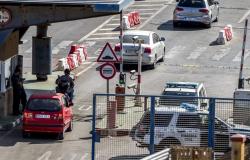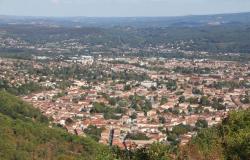Sustainable development in Corbières and Minervois (DDCM), Ecology of Corbières, Carcassonnais and the Aude coast (ECCLA) and EcoHabiter in Corbières and Minervois held a public meeting on Tuesday May 21 in Ferrals-les-Corbières: an appointment given for ” alert, inform and propose” around the question of the accumulation of “megaprojects” of photovoltaic parks, with a “possible multiplication by 50 of the surface currently covered on the sole perimeter of the community of municipalities”.
An “unreasonable development”
This is the paradox, underlined from the first minutes of the public meeting organized Tuesday May 21, at the Cultural Space of Ferrals-les-Corbières, by an informal collective bringing together Sustainable Development in Corbières and Minervois (DDCM), Ecology Corbières, Carcassonnais and the Aude coast (ECCLA) and EcoHabiter in Corbières and Minervois: “Three associations positioned without ambiguity” on the question of the necessary ecological transition and the development of renewable energies (EnR), underlined Franck Turlan (EcoHabiter), at the helm of the evening. But three associations united to “warning of the threat of unreasonable and unconcerted development of ground-based photovoltaics” : alert citizens and elected officials, but also “inform and propose a mode of collective action” in order to arrive at the definition “a shared strategy for the development of photovoltaics”.
Independent – CHRISTOPHE BARREAU
Read also :
How is photovoltaics doing in the Pyrénées-Orientales and Aude? Responses from the director of Enedis
A “emergency” with regard to the exponential curve of “megaprojects” photovoltaic (PV) on the ground: if, over the course of three hours of meeting, the potential project of 220 hectares on Fabrezan-Camplong served as a common thread, it is on the scale of the Corbières territory that the debate wore. With dizzying figures: those of the parks granted, with authorization from the prefecture, with Tournissan1 (on 55 hectares), Tournissan2 (21.5 ha), Albas (34 ha), Ribaute (44 ha); but also in training, in Fraissé-des-Corbières (29.6 ha); or finally in project, with 78.25 ha and 74.08 ha in Saint-André-de-Roquelongue, 62 ha in Fontjoncouse, and therefore 220 in Fabrezan-Camplong. To summarize, while 9.52 MWp (megawatt-peak) of power – we can consider that one hectare is equivalent to one MWp of power – are today installed across the community of communes in the Lézignan region of Corbières Minervois ( CCRLCM), 109 MWp are authorized, 99 under review, and 381 planned. A replica of the appetite of photovoltaic developers on an Aude scale: as of April 4, 244 MWp are operated in the department, for 408 authorized, 520 under instruction, and… 3,955 MWp in project, according to data communicated by management Department of Territories and the Sea (DDTM) and processed by ECCLA.
DR – DR
Serial impacts
Alert, inform and propose: a three-step strategy presented during the nearly 3-hour meeting, with interventions from Jean-Louis Escudier (ECCLA), Maxime Guillaume (DDCM), Hervé Leferrer (winegrower, Domaine du Grand Crès) , Lionel Feuillas (co-president of the league for the protection of birds, LPO) and Eric Ciappara, president of Enercoop Languedoc-Roussillon (developer of citizen and cooperative RES projects). Five actors who, in turn, addressed the fears surrounding the phenomenon, and its potential impacts on landscapes, agriculture, tourism, biodiversity, or “social peace in the villages”. With a certainty hammered home by Franck Turlan around what “is both a big risk and a great opportunity: whether we like it or not, it will develop. We are not talking about a few isolated projects, we are at the beginning of the development of solar”. A forced march to achieve renewable energy production objectives, which on the scale of Occitanie, with the Positive Energy Region strategy, involves a multiplication by 4 by 2030, then by 8 by 2050, of the installed photovoltaic power: “That is to say 15 gigawatts in less than three decades, or what is installed today in France.”
Read also :
Aude: Corbières, new Eldorado for ground-mounted photovoltaic power plants?
Huge objectives which pose the risk of a race for shallots pointed out by Jean-Louis Escudier (ECCLA), going so far as to speak of the “gray tide” to fear, “by letting energy companies appropriate immense natural, agricultural and forest areas, by promising elected officials and farmers an unexpected income”. Engaged in an appeal before the administrative court against the building permits issued for the Tournissan-Ribaute program, Maxime Guillaume (DDCM) highlighted counterintuitive settlement areas, with land in Natura 2000 bird directive or in natural zone of ecological, fauna and flora interest (ZNIEFF): “What may appear as abandoned areas of scrubland has a real use. And this scrubland, like trees, will always be more useful in the fight against climate change than any superficial development.” An argument developed by Lionel Feuillas (LPO) to unfold the potentials “impacts on biodiversity, the big thing forgotten when we talk about climate change” megaprojects : a sad inventory à la Prévert, with changes in temperatures, the CO2 and nitrogen cycle, vegetation, natural and accessible habitats, without forgetting the increase in insect mortality, in 1D line of any food chain.
What proposals?
“Photovoltaics, yes, but not like that.” This summarizes the position of the collective, opposed to “inappropriate choices which threaten the biodiversity and landscapes of Aude”, recalled Jean-Louis Escudier (ECCLA). How, then, in Corbières where projects go through minimum scales of 100 MW, necessary for the profitability of sites which will require the creation of connection stations to “evacuate” the kWh produced towards the very high voltage line which crosses this sector . No doubt by following the maxim delivered by Eric Ciappara (Enercoop): “Developing a territory means first of all taking care of it.”
Read also :
Acceleration of renewable energies in Aude: the switch between wind power and photovoltaics confirmed by the first departmental mapping
But above all it is a stop, transitional, that the collective hopes for, “to bring down the thermometer”, hopes Maxime Guillaume (DDCM), by proposing a one-year moratorium for ground-based photovoltaic projects of more than 15 ha and agrivoltaic projects of more than 5 ha. Enough to authorize reflection, to arrive at a ground-based photovoltaic charter, led by the Corbières-Fenouillèdes regional natural park with the Narbonnaise en Méditerranée PNR, a charter dedicated to integrating climate plans and territorial coherence schemes (Scot) of the CCRLCM and Greater Narbonne. Intercos called upon to force developers to go through local and citizen investment. And for the CCRLCM, the impossibility of doing without a position of “renewable energies-energy sobriety” project manager on such a crucial subject. So many avenues to frame a necessary debate. Because “it’s time to wake up”insisted Franck Turlan, calling on the Corbières vintage to position itself. “Because otherwise, waking up will be painful.”







